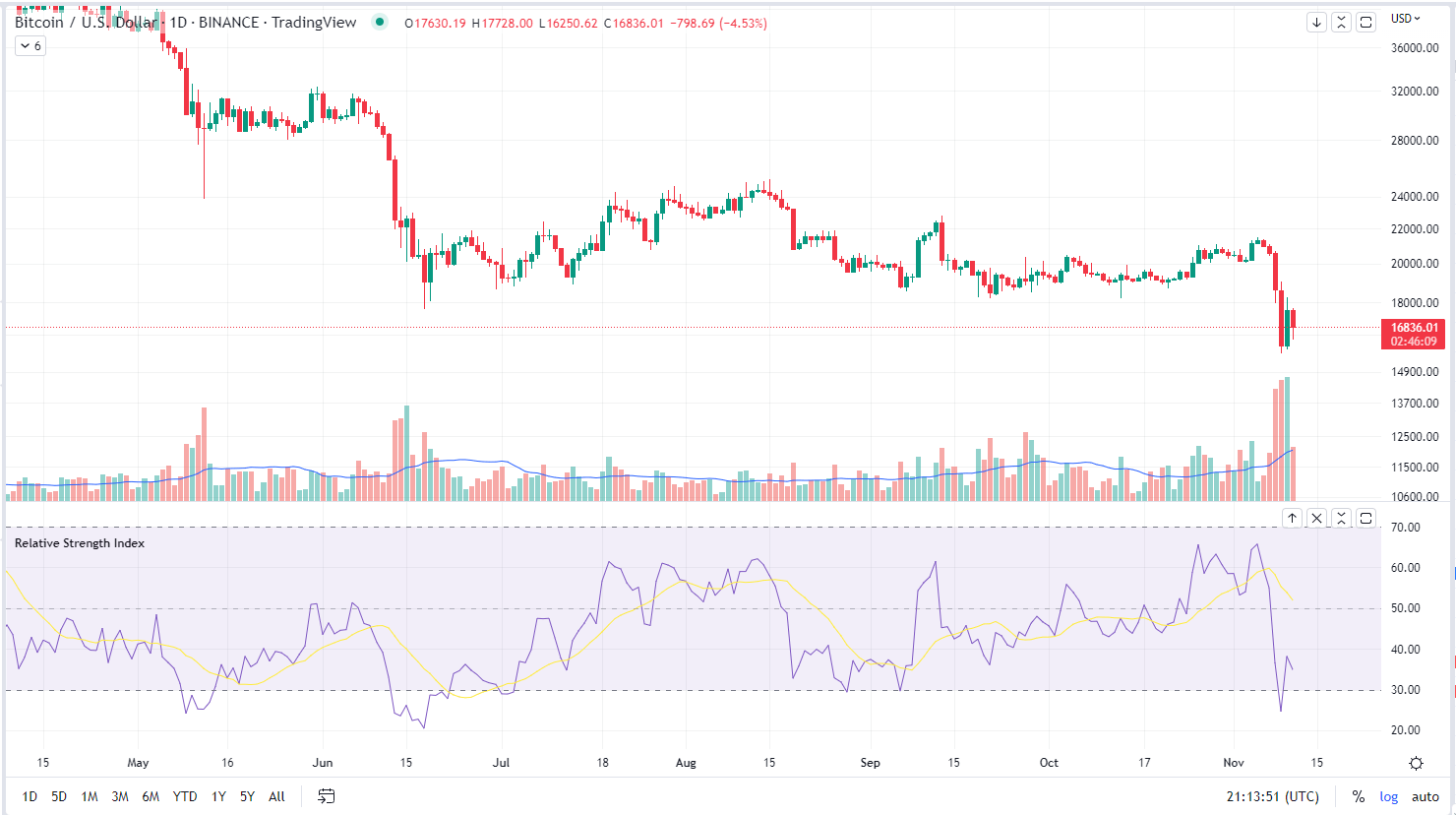Post-FTX, What Happens to Crypto Markets?

What a week.
The bankruptcy of one-time crypto industry powerhouse FTX represents the latest unsavory chapter in an industry regularly rocked by crises.
Yet, cryptocurrencies have historically rebounded to new heights following each calamity. What doesn’t wipe out blockchain and other crypto ventures makes them stronger as new fortified iterations of themselves.
Bitcoin’s (BTC) price has weathered a range of big setbacks, including Mt. Gox, other bankruptcies, security breaches and macroeconomic uncertainties. BTC was most recently trading just under $17,000 after falling below $16,000 earlier in the week for the first time in two years. Its current level puts it within range of its previous high water mark during the crypto bull market of late 2017.
How do markets recover from crypto’s latest black eye? To continue a boxing analogy, we’re still in the early post-apocalyptic rounds. Let’s consider a couple of constants.
- Bitcoin remains a network that allows payments to be sent from one party to another without need of financial intermediation. Its currency, bitcoin, remains a peer-to-peer version of electronic cash, with a capped supply of 21 million coins.
- Ethererum remains a protocol for building decentralized applications. Its ether (ETH) token remains the fuel for the Ethereum network. Ether can still be used to store value, generate yield and process transactions. Ether has recently become a deflationary asset, decreasing in supply for the time being thanks to Ethereum’s recent upgrade, known as the Merge.
The tenets of supply and demand remain in bitcoin and post-Merge ether’s favor. The volume of each is limited and the public, increasingly including institutional investors, remains robust.
But price direction among other cryptocurrencies is uncertain, subject to many different factors including protocols’ ability to execute on their strategies and engage the public.
Separately, an improving economy, a more settled socio-political landscape and clearer crypto regulation in some combination would likely buoy markets. A fresh debacle and sudden economic reversal from the current encouraging signs would likely lead to a downturn and renewed doubts about crypto’s future.
Macroeconomics
Markets received positive news this week, with CoinDesk reporting U.S. consumer prices rose slower than projected for October. The overhang of inflation and the Federal Open Market Committee’s (FOMC) efforts to quell its advance has been an ongoing theme.
To be sure, economic challenges still exist. For instance, the spread between the yields for the 10- and two-year U.S. Treasury bonds remains negative. The inversion of this yield curve, which has been present since July, has historically been a predictor of economic recessions.
But the FOMC remains fully committed to fighting inflation, the biggest long-range threat to the U.S. economy. And the economic landscape appears to be stabilizing, or at least avoiding market moving surprises.
Technical levels
To say that BTC and ETH have been oversold as FTX has disintegrated is an understatement. Yet, investors should not see this trend as a clarion call to buy, particularly as prices have rebounded over the past couple of days and are not as oversold.
The Relative Strength Index (RSI) for BTC and ETH is 35 and 40, respectively. RSI levels under 30 are generally a signal that an asset’s price is undervalued.
Based on past data, BTC and ETH’s RSI levels don’t imply much movement over the next 30 days.
Since 2015, BTC’s RSI has fallen between 30 and 50 on 1,005 occasions. Since 2017, ETH’s RSI has maintained the same range 682 times.
The average 30-day performance following those occurrences since that time has been -1.1% for ETH and 3.03% for BTC.
Bitcoin and ether’s respective $20,000 and $1,300 support levels of a week ago will now likely represent resistance.

Bitcoin 11/11/2022 (TradingView)
On-chain data
On-chain data shows a decline in BTC and ETH transferred to centralized exchanges following a spike on Nov. 9.
This bears watching because coins are often sent to exchanges prior to offloading. Historical data for this metric must also be used as a less reliable benchmark.
Given the turmoil, I would expect investors to hold their coins on exchanges for much shorter periods of time, using exchanges as transactional vehicles only.
Funding rates for BTC, often used as an indicator of sentiment, have turned positive again after two sharp moves down.
The final verdict will depend on the individual’s time horizon. Contagion effects are still working their way through markets, not to mention the looming overhang of government regulation.
Bitcoin and ether’s core principles remain unchanged. As such, recent turmoil may represent a unique opportunity for bullish investors, albeit not without additional challenges.






 Bitcoin
Bitcoin  Ethereum
Ethereum  Tether
Tether  USDC
USDC  TRON
TRON  Dogecoin
Dogecoin  Cardano
Cardano  Bitcoin Cash
Bitcoin Cash  Chainlink
Chainlink  Monero
Monero  LEO Token
LEO Token  Zcash
Zcash  Stellar
Stellar  Litecoin
Litecoin  Hedera
Hedera  Dai
Dai  Cronos
Cronos  Tether Gold
Tether Gold  OKB
OKB  Ethereum Classic
Ethereum Classic  KuCoin
KuCoin  Gate
Gate  Algorand
Algorand  Cosmos Hub
Cosmos Hub  VeChain
VeChain  TrueUSD
TrueUSD  Dash
Dash  Tezos
Tezos  Stacks
Stacks  IOTA
IOTA  Basic Attention
Basic Attention  Theta Network
Theta Network  Decred
Decred  NEO
NEO  Synthetix
Synthetix  Qtum
Qtum  Ravencoin
Ravencoin  DigiByte
DigiByte  0x Protocol
0x Protocol  Nano
Nano  Zilliqa
Zilliqa  Siacoin
Siacoin  Numeraire
Numeraire  Waves
Waves  BUSD
BUSD  Status
Status  Enjin Coin
Enjin Coin  Pax Dollar
Pax Dollar  Ontology
Ontology  Hive
Hive  Lisk
Lisk  Steem
Steem  Huobi
Huobi  NEM
NEM  OMG Network
OMG Network  Bitcoin Gold
Bitcoin Gold  Augur
Augur  Bitcoin Diamond
Bitcoin Diamond  HUSD
HUSD  Ren
Ren